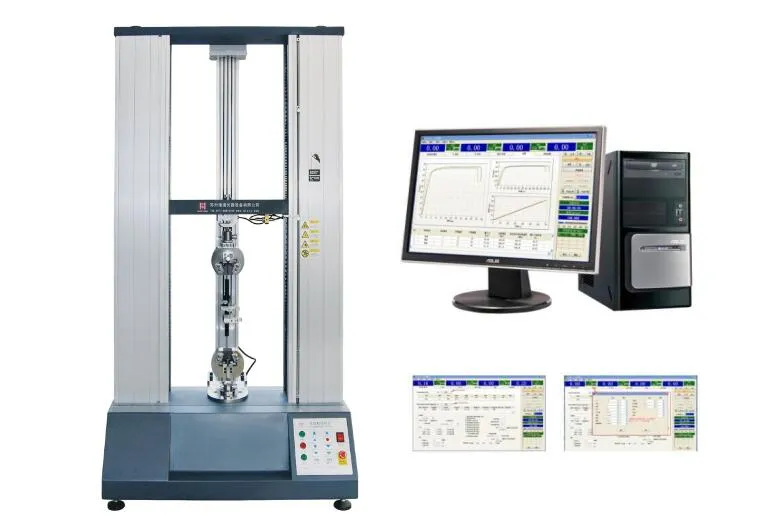Things about Metal Material Testing Machine
2024-11-07
Metal material testing machines are specialized equipment used to evaluate the properties of metals to ensure they meet quality and safety standards for various applications, from construction to manufacturing. These machines assess metals' mechanical, physical, and sometimes chemical properties through various tests. Here’s an overview of common types of metal testing machines and what they measure:

1. Tensile Testing Machine
- Purpose: Measures the tensile strength, yield strength, and elongation of a metal.
- How It Works: A sample metal specimen is clamped at both ends and subjected to a pulling force until it breaks. The machine records the amount of force required to break the metal and the metal’s deformation, providing data on how much stress the material can withstand.
2. Hardness Testing Machine
- Purpose: Assesses the hardness of a metal, which correlates to its resistance to indentation, scratching, and wear.
- Common Types:
- Rockwell Hardness Tester: Measures hardness by pressing an indenter into the material and measuring the depth of the indentation.
- Brinell Hardness Tester: Uses a hardened steel or carbide ball pressed into the material with a set force, measuring the diameter of the indentation.
- Vickers Hardness Tester: Uses a diamond pyramid indenter to make an indentation and measures hardness based on the indentation’s area.
3. Impact Testing Machine
- Purpose: Measures a metal’s ability to absorb energy and resist sudden impacts, which indicates its toughness.
- Common Tests:
- Charpy Impact Test: A pendulum strikes a notched metal specimen, breaking it, and the machine measures the energy absorbed during the break.
- Izod Impact Test: Similar to Charpy, but the specimen is held vertically, and the impact is applied differently.
- Applications: This test is crucial for materials used in high-stress applications like bridges and automotive parts, where sudden impacts can occur.
4. Compression Testing Machine
- Purpose: Tests the compressive strength of metals, assessing how well they withstand compressive forces without deforming.
- How It Works: A sample metal specimen is subjected to gradual compressive force until it fails. This test helps determine the material’s behavior under pressure, which is important for applications where metals bear loads.
5. Fatigue Testing Machine
- Purpose: Tests how a metal behaves under repeated loading and unloading cycles, evaluating its fatigue strength.
- How It Works: The machine repeatedly applies cyclic loads to a metal specimen to simulate real-life operating conditions, measuring how long the metal can withstand these cycles before failing.
- Applications: Commonly used for metals in automotive and aerospace applications, where materials are subjected to repeated stresses.
6. Bend Testing Machine
- Purpose: Tests the ductility and flexibility of metals by bending them to a specific angle or until they break.
- How It Works: The machine applies force to bend the metal sample over a fixed angle, measuring how far it can bend without breaking or cracking.
- Applications: Useful in assessing metals used in structures, pipelines, and products where flexibility is essential.
7. Creep Testing Machine
- Purpose: Measures a metal’s resistance to deformation under constant stress and high temperatures over long periods.
- How It Works: The machine applies a constant load at elevated temperatures to see how the metal deforms over time. This is critical for metals used in high-temperature environments like power plants and jet engines.
8. Metallographic Testing Machine
- Purpose: Examines the microstructure of metals to assess characteristics like grain size, phase distribution, and other structural elements.
- How It Works: Specimens are cut, polished, and etched to reveal their microstructure, then analyzed under a microscope.
- Applications: Common in quality control to detect structural imperfections or inconsistencies that may impact material performance.
9. Ultrasonic Testing Machine
- Purpose: Uses ultrasonic waves to detect internal flaws or discontinuities in metals.
- How It Works: Ultrasonic waves are transmitted through the metal, and the reflections of these waves are analyzed to find cracks, voids, or other imperfections.
- Applications: Often used in non-destructive testing (NDT) for components that cannot be destructively tested, such as pipeline welds or large structural parts.
10. Spectrometer for Chemical Analysis
- Purpose: Determines the chemical composition of a metal.
- How It Works: A sample is excited by a spark, and the emitted light is analyzed to determine the concentration of elements present.
- Applications: Used in quality control and to confirm that metal alloys meet specific chemical composition standards.
Summary
These testing machines are essential for ensuring that metal materials meet strict safety, durability, and performance standards for their intended applications. From testing hardness and tensile strength to examining chemical composition and microstructure, each machine plays a unique role in evaluating metal properties in a controlled and reliable way.


